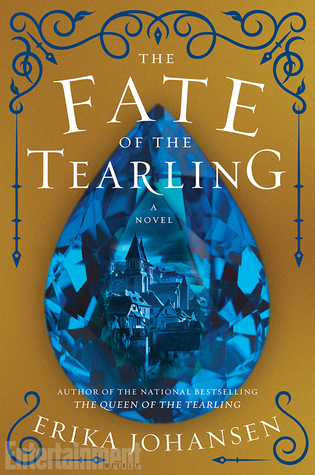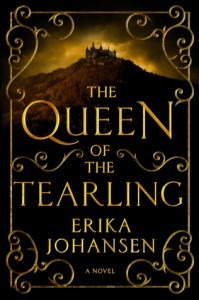 The Fate of the Tearling (The Queen of the Tearling, #3) by Erika Johansen
The Fate of the Tearling (The Queen of the Tearling, #3) by Erika Johansen Formats available: hardcover, paperback, ebook, audiobook
Series: Queen of the Tearling #3
Pages: 496
Published by Harper on November 29th 2016
Publisher's Website, Amazon, Barnes & Noble, Kobo, Bookshop.org
Goodreads
The thrilling conclusion to the New York Times bestselling Tearling trilogy.
In less than a year, Kelsea Glynn has transformed from a gawky teenager into a powerful monarch. As she has come into her own as the Queen of the Tearling, the headstrong, visionary leader has also transformed her realm. In her quest to end corruption and restore justice, she has made many enemies—including the evil Red Queen, her fiercest rival, who has set her armies against the Tear.
To protect her people from a devastating invasion, Kelsea did the unthinkable—she gave herself and her magical sapphires to her enemy—and named the Mace, the trusted head of her personal guards, Regent in her place. But the Mace will not rest until he and his men rescue their sovereign, imprisoned in Mortmesne.
Now, as the suspenseful endgame begins, the fate of Queen Kelsea—and the Tearling itself—will finally be revealed.
My Review:
 This was awesome. As is the entire trilogy, starting with The Queen of the Tearling and moving right through The Invasion of the Tearling. If you like epic fantasy with a touch of SF, get thee hence and pick up Queen right now. This series is perfectly sized for holiday week binging.
This was awesome. As is the entire trilogy, starting with The Queen of the Tearling and moving right through The Invasion of the Tearling. If you like epic fantasy with a touch of SF, get thee hence and pick up Queen right now. This series is perfectly sized for holiday week binging.
At the beginning of the saga, back in Queen, it seemed as if this was pure epic fantasy. Starting in Invasion and particularly in this final book, we see where the story has its roots in SF. Somehow, in ways that are deliberately not made clear, the ancestors of the Tearling made their way from a near-future dystopian Earth to Tear. And deliberately turned their backs on late 21st or early 22nd technology in an attempt to create an agrarian utopia.
Kelsea, physically locked in captivity by the Red Queen of Mortmesne, takes a psychic journey back down through the timeline to see the origins of that long-ago utopia. While Kelsea is looking through the eyes of young Katie Rice three centuries ago, she sees William Tear’s dream of a perfect world die inch by inch, in ways that still have consequences all these generations later.
The problem with attempting to create a perfect world is that the people who populate it are never perfect. Not because they don’t try, but because people simply aren’t, even when they are not deliberately evil. Not that THAT isn’t a factor as well.
Kelsea starts out the story wanting to save her kingdom. She discovers that in order to save her kingdom, she must save the world. In the end, she can’t even manage to save herself.
And yet she does. And she doesn’t.
Escape Rating A: It takes a while for this final book to build to its epic, and thought-provoking, conclusion. As Fate opens, Kelsea is imprisoned, and has no freedom of action. She’s also not thinking too clearly.
Much of the first half of the book is carried by other characters – lots of other characters. The perspective and point of view switch often, and at first it’s just a bit jarring. The reader just has a grasp of one thread when the perspective switches to someone else at a different place, and sometimes at a different time.
Some of those perspectives are obvious – Kelsea’s regent back in the Tearling, the Red Queen in Mortmesne, various other leaders. But some are down among the rank and file, as we see a “lower-decks” version of the ways in which the world is falling apart, and the ways that everyone is using to even attempt to keep it together. Along with the ones who just don’t give a damn.
And the most important perspective of all, besides Kelsea’s in the present, is Katie’s in the past, at the beginning of the Tearling. While we begin with Katie as a child, as she grows up she sees the colony change from what seems like almost a working utopia to a god-bothered, fear-obsessed, evil theocracy. And that’s what survived to Kelsea’s present and has helped to make the current mess into the giant clusterfuck it now is. And there doesn’t seem to be any way in the present to save the day.
But in the view of the past, there is a whole lot being said about the way that the world, any world, works and doesn’t. It’s not difficult for the reader to draw parallels from the Tearling to 21st century America. Which is also a way of coming full circle, as it’s the results of our NOW that the Tear colonists fled which begins Kelsea’s entire saga.
And the implications of all of that will keep you thinking long after you turn the final page.
Reviewer’s Note: The way that The Fate of the Tearling manages its end reminds me strongly of Inherit the Stars by Laurie A. Green, with its choices about extreme means justifying shattering ends, and who does and doesn’t pay the price. If the ending of The Fate of Tearling leaves you gasping, and you want more with a similar heart-stopping and thought-provoking affect, pick up Inherit the Stars for a purely science fictional twist on some of the same results.

